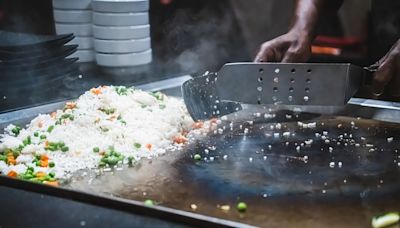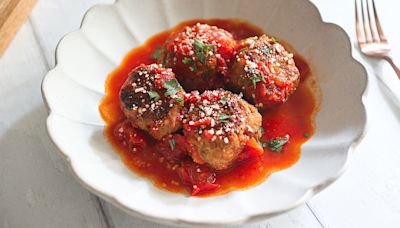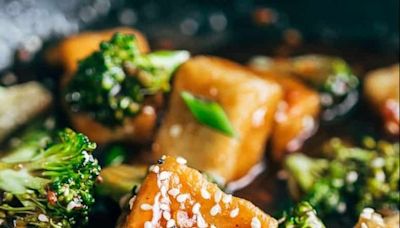Search results
Food Recipes Japanese Dishes - Yahoo Recipe Search
YummlyThis flavorful, fragrant curry is a hearty comfort food. It makes a great meal all year round, but it's particularly wonderful on chilly nights when you want to enjoy a hearty bowl of something steaming. Pork and vegetables make up the recipe's foundation, but the flavor is truly elevated by Asian-inspired flavors like red miso, fresh ginger, and curry. Serve it over sticky Japanese rice for a one-bowl meal, or accompany it with a fresh salad or pickled vegetables. ## Japanese Curry Roux This recipe calls for Japanese brick curry, which can typically be found at most grocery stores or specialty Asian grocery stores. It's very easy to use — simply add it to your dish for that delicious curry flavor. These bricks are available in a hot, medium, or mild options. ## Japanese Curry Vs Indian Or Thai Curry You may be curious to know how Japanese curry is different from Indian curry. This classic Japanese food is thicker and has a milder flavor than other types, and is often made with curry roux or a curry sauce mix, as mentioned above. Many Indian and Thai curries are made with coconut milk and curry powder and other spices, instead of a curry brick. Many Japanese curries occasionally incorporate other ingredients such as Worcestershire sauce, soy sauce, or tomato paste to deepen the flavor, but you can always opt to omit them, as this recipe suggests. ## Variations _Bread your pork:_ Breaded pork cutlets with curry sauce is very popular among Japanese cuisine. To try this option, coat your pork in panko breadcrumbs and fry it, before slathering in curry sauce and combining with the vegetables. _Serve over noodles instead of rice:_ If you don't like rice, you can top udon noodles, soba noodles, or rice noodles with your curry. Add a splash of soy sauce to for a bit of umami flavor to your bowl. _Use chicken breasts, steak or seafood instead of pork:_ Instead of pork, feel free to try a different type of protein, or even use vegetables like butternut squash or sweet potatoes. Just be sure to chop whatever protein or vegetables you use into bite-sized pieces. ## Make-Ahead Meal The total time to make this Japanese-style curry is less than an hour, making it easy to put together any night of the week. You can also choose to meal prep this dish over the weekend, and enjoy it all week long. The curry can be refrigerated for up to five days or frozen for up to three months.Food.comTed Allen is best known for being the food and wine guy on Bravo's popular Queer Eye For The Straight Guy. But he was an accomplished cook and writer long before Bravo. This a great recipe because it takes little effort and produces results that make people think otherwise. Allen says you can add cooked chicken or shrimp or asparagus to this dish. I like it with soba, a Japanese-style noodle made from buckwheat, but you can make it with penne, fettuccine, or farfalle, as well.Food.comMake and share this Korean Gaji Namul (Korean Eggplant Side Dish) recipe from Food.com.Apr 15, 2024 · Top 33 Japanese Seafood Dishes. Last update: Mon Apr 15 2024. shutterstock. VIEW MORE. View all Japanese Seafood Dishes. View Japanese Seafood Dishes map. 01. Rice Dish. Kaisendon. JAPAN. 4.6. shutterstock. Ate it? Rate it. Wanna try? Add to list. MAIN INGREDIENTS. Uruchimai. Tuna. Shrimps. Salmon. Scallops. Uni. Crab. Ikura. Nori. Gari.
- 29 Best Meat Dishes in Japan
Top 29 Japanese Meat Dishes. Last update: Mon Apr 15 2024....
- 20 Best Fish Dishes in Japan
What to eat in Japan? Top 20 Japanese Fish Dishes. Last...
- 29 Best Meat Dishes in Japan
Apr 16, 2024 · The list of healthy foods and produce goes on, but these are just some common and some not-so-common ones you can find in Japanese cuisine! Explore: Healthy Japanese Recipes
Apr 18, 2024 · For today’s post, we have created a list of delicious and healthy Japanese dishes that you have to try while in Japan. Please note that some of these dishes may not impress your tastebuds as they need an acquired taste, but nevertheless give them a try for their amazing health benefits.
Apr 10, 2024 · Originally created as shojin ryori (Buddhist vegan cuisine), Ganmodoki are delicious Japanese fried tofu patties with hijiki seaweed, shiitake, and edamame. Crispy on the outside yet soft and fluffy inside, freshly made ganmodoki are irresistible! {Vegan Adaptable}
Apr 11, 2024 · Tekka don (鉄火丼) is a Japanese rice bowl topped with tuna sashimi that has been marinated in a savory/sweet mixture of sake, soy sauce and mirin. Typical garnishes include thinly sliced nori and shiso leaves, chopped scallions and sesame seeds. In some ways it’s similar to the poke bowls served in Hawaii.














